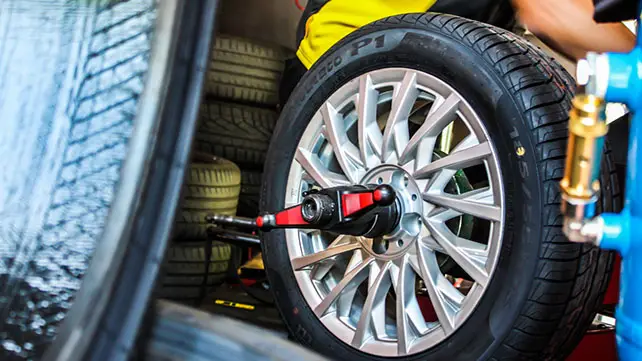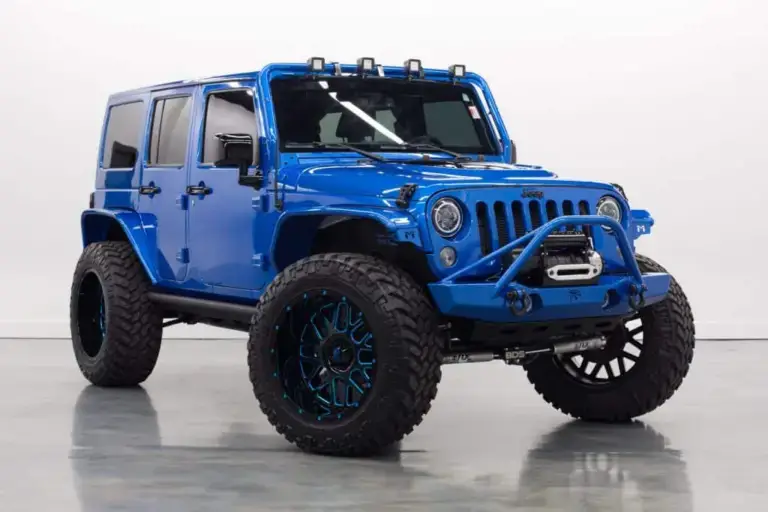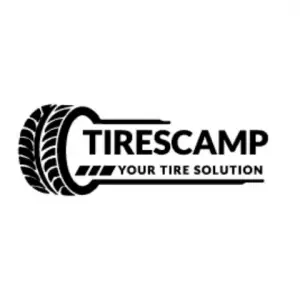Generally, it is not safe to mix tire and rim sizes. Tires and rims are designed to match a specific size and measurements.
So, Can you put 18 inch tires on 17 inch rims?
You cannot put 18” tires on 17” rims as the tire will not seal with the rim properly causing safety hazards. Also, uneven tire and rim sizes can cause handling, braking, and tire wear issues. Follow the manufacturer’s specifications for tires and rim sizes before mixing these measurements.
As it is not safe to put 18” tires on 17” rims, there are several reasons why you cannot do this. Follow the article to find out more about tire options for 17” rims.
Why You Cannot Put 18” Tires on 17” Rims?
First of all, you cannot put 18” tires on 17” rims. This is because tires and rims will only be compatible based on the diameter and width of the tire and wheel. A specific diameter tire will fit a specific diameter rim.
Although the width of the tire can be changed with little flexibility, the diameter cannot be changed. Diameter is one thing that fits only if it matches between the tire and the rim. For example, P215/65R17 size tire will only fit on a 17” rim.
So, there’s that, although it will be easier for you to install an 18” tire on a 17” rim, it will not be safe, will slip off, and will not hold air. Similarly, you cannot put 37-inch tires on 16-inch rims for the same reason. Here it is explained extensively why you cannot.
There are several good reasons why you cannot put an 18” tire on a 17” rim. Basically, you’ll need to stick to the diameter of the rim if changing the tire. So, let’s get to the details of the reasons.
Reason 1: Braking & Safety Issues
The 18” tire will come loose on a 17” rim. As a result, when you brake, the tire might cause safety hazards like slipping off. Also, for the added weight, braking will be difficult as the braking distance will increase. You’ll need to recalibrate your speedometer.
But that is another thing as you should not, I repeat do not put the 18” tire on your 17” rim. It is totally not safe. There won’t be a tight seal between the tire and the rim. As a result, it will not only be difficult to make corners and drifts, but rather dangerous.
Reason 2: Handling Issue
First of all, increasing the tire diameter to your stock rim will cause handling issues. When you put on an 18” tire on a 17” rim, there will be space left between the wheel and the tire causing airflow. As a result, the tire will not hold the rim tightly and increasing speed will cause the tire to slip off.
Also, it is physically impossible to install the 18” tire on the 17” rim for many reasons. Car engineers work closely with the tire specialist to design the car specifications which can accommodate only some specific tire sizes, especially the tire diameter.
Reason 3: Performance Issue
As your tire diameter is increased compared to the rim, there will be some performance issues. It can seem virtually harmless or even plausible for 18” on 17” rims, what one inch can do! You might ask. But little specifications matter the most when it comes to your car’s internal engine and performance calculations.
A larger tire will add more weight to your car and this will reduce engine performance and acceleration ability. While you think you’ll enjoy a larger tire on your 17” rim, your car’s engine will think otherwise.
Also, as the tire won’t be able to hold air, the tire will not be inflated. As a result, traction will be an issue as well as reduced engine performance.
Another important consideration is axle weight of the wheel will also increase leading to dull tire condition. This will result in further acceleration loss and less accurate cornering ability.
Also, as the chassis height and the gravity center change, the car’s behavior will change with a direct impact on rolling resistance and oscillation.
Reason 4: Tire Wear
As the larger 18” tire on a smaller 17” rim will come loose, the air will not hold inside the wheel. As a result, a slight acceleration will cause the tire to have extreme wear and tear.
And, if this happens in the middle of the road, well there’s a considerable amount of safety hazards waiting for you. So, you cannot possibly put on an 18” tire on a 17” rim.
Mythbusting
Now, in recent times, there has been an increased amount of popularity for larger tires among auto lovers. It even got to the stage where only the look matters to the owner rather than the subtle measurements. Everyone wants a large tire, no matter the issues.
For example, if you want to buy the biggest tires on stock f350, some myths regarding larger tires will help you.
Well, there are several myths regarding increasing the wheel diameter. A larger tire actually does pay off in many aspects of your car. Most auto owners usually go for a larger tire for performance or cosmetic purposes. Let’s bust the myths open.
01. Fuel Economy & Acceleration:
Most auto owners often opt for a larger tire without considering the impact on the car and its engine. In most cases, with a larger tire on a stock-size diameter wheel, the extra weight wears down the engine. This causes a reduced fuel economy.
Also, as for the extra weight, if the engine is not powerful enough, acceleration will be a problem. This is why tires are manufactured considering all of the engine and car specifications. And this is why you should consider all of the specifications before going for a larger tire.
02. Traction & Road Grip Issues:
One of the positive sides of a larger tire is that it increases road grip. But if you change the diameter, it will impact your traction control feature as well as ESP.
But on a car equipped with a larger diameter tire, you can have increased maneuvering and performance as well as traction. On a wet or dry road, you’ll have a better grip on a larger tire. Also, you’ll have an excellent off-road experience with a larger tire with an increased road grip.
So example, 33 vs 35” tires f250 can be a good bet for traction & enhanced road grip as these are larger tires.
03. Cost & Adjustments:
Larger tires will surely add extra costs as they will cause more stoppage at gas stations. Also, you’ll need to adjust the larger tire with your car’s fender and ground clearance. You also may need to use leveling of lifting kits. These will be added to the costs.
04. Possible Warranty Void:
Although it is appealing and stylish to put on larger tires, some manufacturers will void your warranty for modifying the suspension with lifting kits and larger tires. So, consult with the manufacturer first before changing to a larger tire. And also check if the larger tire is having any effect on Advanced Driver Assistance Systems.
Other Modifications To Improve Vehicles’ Aesthetic Appeal
01. Plus-Sizing Your Tire:
Plus-sizing is the process where you increase the wheel diameter by maintaining the stock wheel diameter with a low profile. This will not hamper the clearance or speedometer issues.

Based on your car specifications, plus-sizing can increase handling performance and cornering abilities. This is generally for cosmetic purposes.
02. Up-Sizing Your Tire:
Up-sizing means you’re deviating from your tire’s original diameter and installing the bigger diameter tire on wheels with the same or larger diameter. In that case, you’ll have to change the wheel to a larger diameter. This will impact the clearance and speedometer. You’ll need to recalibrate your speedometer.
Also, up-sizing will cause trouble as the larger tire will weigh down the wheel assembly. Along with that, it will impact the fuel economy as the engine will need more power and fuel.
There will be unnecessary stress on the brakes and powertrain. If up-sized incorrectly, the tire will rub against the brake calipers, wheel well, and vehicle frame resulting in the potential wearing down any parts it rubs against.
03. Tread Pattern:
You can also go for a more aggressive and dynamic tread pattern when putting on a larger tire. This will also increase the aesthetic appeal of your truck or car. There are various tread patterns for off-roading also that prevents from rock getting stuck inside the treads.

Also, based on the surface of your driving area, you can get better traction and road grip with these tread patterns.
04. Tire Highlighting:
You can also highlight your tires with various stylish markings or texts that will increase the cosmetic look of your vehicle.
Frequently Asked Questions (FAQs):
Can Wrong-Size Tires Damage The Car?
Yes, wrong-size tires can damage the car and even cause safety hazards. If you do change the tires without thorough measurement compatibility of tires and rims, it will cause safety issues like braking relapse, tire wear, etc.
Should All 4 Tires Be The Same Size?
Yes, all 4 tires should be the same size for optimal driving performance and safety. Same tires in every wheel will ensure the driver has the same tread pattern, speed ratings, and load index. Thus, driving will be comfortable and safe.
Is Higher Traction Better?
Yes, the more traction the better your driving experience gets. Traction is considered as the force in the footprint of the tire. And there are many things that impact traction control such as tire and rim size and diameter, road surface, etc.
Conclusion
So, can you put 18-inch tires on 17-inch rims? As I have discussed, do not do this. And always discuss with your vehicle’s manufacturer before going for a larger tire. Give safety and engine performance priority over stylish looks.
